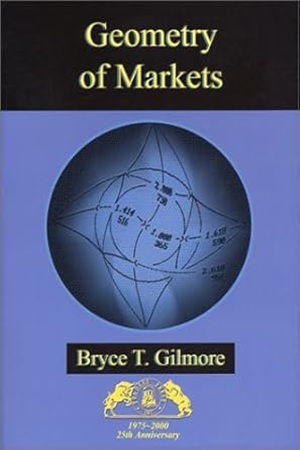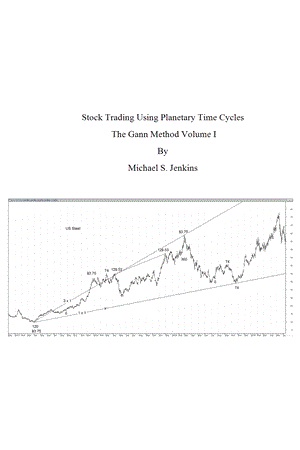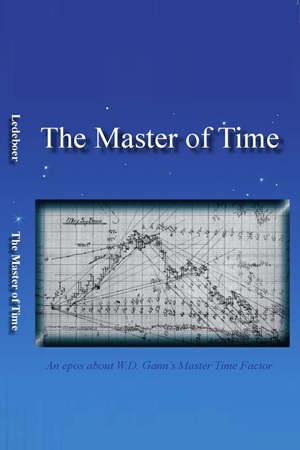Geometry of Markets
28.20 $
🎯Core Concepts:
- Time & Cycle Studies
- Proportions & Levels
- Trading & Strategy
Bryce T. Gilmore’s Geometry of Markets (Volumes 1 & 2) is a comprehensive exploration of the geometric, cyclical, and mathematical foundations of financial market behavior. Drawing on W.D. Gann’s principles and expanding them with his own discoveries, Gilmore provides traders with a step-by-step manual for applying ancient geometry, Fibonacci ratios, and time/price squaring techniques to modern markets.
Volume 1 lays the groundwork by explaining the theory of time relationships in markets, planetary and seasonal cycles, and the role of ancient geometry—squares, circles, triangles, golden ratios, and the Great Pyramid of Giza—in market forecasting. It details static and dynamic price levels, the squaring of time and price, and the concept of vibrations, where market moves relate to each other through harmonic ratios. Real-world case studies, such as the 1970–1974 Australian market decline and the 1987 crash, illustrate these timeless principles in action.
Volume 2 builds on these foundations with advanced methods. It introduces time and price tools, bar chart structures, composite time counts, solar cycles, Gann angles, Elliott Wave applications, and cycle analysis. Key techniques such as “Windows of Opportunity,” planetary orbits, and lunar cycles are integrated with Gann’s geometric framework. The volumes culminate with professional-level strategies, money management principles, trading rules, and a practical Trading Plan & Checklist for disciplined execution .
Together, these two volumes form one of the most detailed and practical guides to applying Gann’s geometric and cyclical methods. Traders seeking to trade for a living will find in Gilmore’s work both the philosophical depth of ancient mathematics and the pragmatic tools required to forecast price and time with accuracy.
💡 What You’ll Learn:
- The theory of time relationships in markets, including planetary and seasonal cycles.
- How to apply ancient geometry: squares, circles, triangles, golden ratios, and pyramids.
- Methods of static and dynamic support and resistance using Fibonacci and Lucas numbers.
- Squaring of time and price to identify future turning points.
- The role of wave forms, vibrations, and market sentiment in cycle forecasting.
- Advanced techniques: composite time counts, solar cycles, Gann angles, Elliott Wave structures, and trend analysis.
- How to locate Windows of Opportunity for major reversals.
- Professional trading tools: money management systems, trading rules, and a detailed trading plan.
Table of Contents:
Volume 1:
- THE THEORY BEHIND TIME RELATIONSHIPS IN MARKETS
- THE SCIENCE OF MATHEMATICS
- IMPORTANT STATIC TIME ELEMENTS CAN SIGNAL A CHANGE IN TREND
- STATIC PRICE INCREMENTS AND LEVELS FOR SUPPORT & RESISTANCE AREAS
- DYNAMIC PRICE SUPPORTS AND RESISTANCES
- SQUARING PRICE FOR LOCATION OF FUTURE SUPPORT AND RESISTANCE ZONES
- DYNAMIC TIME SUPPORTS AND RESISTANCES
- CHART SCALING OF TIME AND PRICE
- FUTURE TIME SQUARING$ OF PRICE
- RATIO ANALYSIS OF PRICE RETRACEMENTS AND PRICE PROJECTIONS
- GEOMETRIC VIBRATION ANGLES
- EFFECTIVELY USING TIME SIGNALS FOR TRADE TIMING
- RECORDING STOCK OR COMMODITY PRICE HISTORY
- STEPS REQUIRED FOR COMPREHENSIVE TIME & PRICE ANALYSIS
- RULES FOR CONFIRMING IMPORTANT MARKET VIBRATIONS
- HELIOCENTRIC PLANETARY CYCLES
Volume 2:
- TIME & PRICE TOOLS
- REVERSAL PATTERNS
- TREND ANALYSIS
- ELLIOTT WAVE ANALYSIS
- CYCLES
- WINDOWS OF OPPORTUNITY
- TRADING FOR PROFITS
Geometry of Markets By Bryce T. Gilmore
| Author |
Bryce T. Gilmore |
|---|---|
| Pages |
416 |
| File Types |
|









